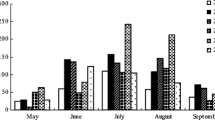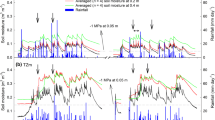Abstract
The application of nitrogen in a soil under agricultural production is subject to several pathways including de-nitrification, leaching and recovery by an annual crop. This is as well greatly influenced by the management practices, nitrogen source and soil conditions. The main objective of this study was to investigate the loss of nitrogen (N) through nitrous oxide (N2O) emissions and mineral N leaching and uptake by annual crop as influenced by the N source. The study was carried out at Kabete in Central Kenya. Measurements were taken during the second season after two seasons of repeated application of N as urea and Tithonia diversifolia (tithonia) leaves. Results obtained indicated that nitrous oxide (N2O) emissions at 4 weeks after planting were as high as 12.3 μg N m −2 h−1 for tithonia treatment and 2.9 μg N m−2 h−1 for urea treatment. Tithonia green biomass treatment was found to emit N2O at relatively higher rate compared to urea treatment. This was only evident during the fourth week after treatment application.Soil mineral N content at the end of the season increased down the profile. This was evident in the three treatments (urea, tithonia and control) investigated in the study. Urea treatment exhibited significantly higher mineral N content down the soil profile (9% of the applied N) compared to tithonia (0.6% of the applied N). This was attributed to the washing down of the nitrate-N from the topsoil accumulating in the lower layers of the soil profile. However, there was no significant difference in N content down the soil profile between tithonia treatment and the control. It could be concluded that there was no nitrate leaching in the tithonia treatment. Nitrogen recovery by the maize crop was higher in the urea treatment (76% of the applied N) as compared to tithonia treatment (55.5% of the applied N). This was also true for the residual mineral N in the soil at the end of the season which was about 7.8% of the applied N in the urea treatment and 5.2% in the tithonia treatment.From this study, it was therefore evident that although there is relatively lower N recovery by maize supplied with tithonia green biomass compared to maize supplied with urea, more nitrogen is being lost (through leaching) from the soil–plant system in the urea applied plots than in tithonia applied plots. However, a greater percentage (37.8%) of the tithonia-applied N could not be accounted for and might have been entrapped in the soil organic matter unlike urea-applied N whose greater percentage (92%) could be accounted for.
Similar content being viewed by others
References
Addiscott T.M. 1996. Fertilizers and nitrate leaching. In: Hester R.E. and Harrison R.M.(eds) Agricultural Chemicals and the Environment. Issues in Environmental Science Technology, Vol. 5, pp. 1–26.
Anderson J.M. and Ingram J.S.L. (1993). Tropical Soil Biology and Fertility: A Handbook of Methods. CAB International, Wallingford, UK
Babbar L.I. and Zak D.R. (1996). Nitrogen losses from coffee agroecosystems in Costa Rica: leaching and denitrification in the presence and absence of shade trees. J. Environ. Qual. 24: 227–233
Brady N.C. and Weil R.R. (1999). The Nature and Properties of Soils, 12th ed. Prentice-Hall, Inc., New Jersey
Christianson C.B., Bationo A., Henao J. and Vlek P.L.G. (1990). Fate and efficiency of N fertilizers applied to millet in Niger. Plant Soil 125: 221–231
Di H.J. and Cameron K.C. (2002). Nitrate leaching in temperate agroecosystems: sources, factors and mitigating strategies. Nutr. Cycl. Agroecosyt. 46: 237–256
Dixon R.K. (1995). Agroforestry systems: sources or sinks of greenhouse gases?. Agroforest. Syst. 31: 99–116
FAO (Food and Agriculture Organization) 1990. New Environmental Threat: Declining Soil Fertility. Land and Water Technical Newsletter.
Gachengo C.N., Palm C.A., Jama B. and Otieno C. (1999). Tithonia and senna green manures and inorganic fertilizers as phosphorus sources for maize in Western Kenya. Agroforest. Syst. 44: 21–36
Giller K.E. and Cadisch G. (1995). Future benefits from biological nitrogen fixation: an ecological approach to agriculture. Plant Soil 174: 255–277
Glasener K.M. and Palm C.A. (1995). Ammonia volatilization from tropical legume mulches and green manures on unlimed and limed soils. Plant Soil 177: 33–41
Hagedorn F., Steiner K.G., Sekayange L. and Zech W. (1997). Effect of rainfall pattern on nitrogen mineralization and leaching in a green manure experiment in South Rwanda. Plant Soil 195: 365–375
Haggar J.P., Tanner E.V.J., Beer J.W. and Kass D.C.L. (1993). Nitrogen dynamics of tropical agroforestry and annual cropping systems. Soil Biol. Biochem. 25: 1363–1378
ICRAF 1995. Laboratory Methods for Soil and Plant Analysis: Version 1.1. Nairobi.
Janzen H.H. and Schaalje G.B. (1992). Barley response to nitrogen and non-nutritional benefits of legume green manure. Plant Soil 142: 19–30
Jones R.B., Snapp S.S. and Phombeya H.S.K. (1997). Management of leguminous leaf residues to improve nutrient use efficiency in the sub-humid tropics. In: Cadisch, G. and Giller, K.E. (eds) Driven by Nature: Plant Litter Quality and Decomposition, pp 239–250. CAB Int., Wallingford, England
Kimetu J.M. (2002). Nitrogen fertilizer equivalency values for organic materials of contrasting qualities based on maize performance at KabeteKenya. Kenyatta University, Nairobi, Kenya, 74
Kimetu J.M., Mugendi D.N., Palm C.A., Mutuo P.K., Gachengo C.N., Bationo A., Nandwa S. and Kungu J.B. (2004). Nitrogen fertilizer equivalencies of organic materials of differing quality and optimum combination with inorganic nitrogen sources in Central Kenya. Nutr. Cycl. Agroecosyst. J. 68: 127–135
Kruijs A.C.B.M., van Wong M.T.F., Juo A.S.R. and Wild A. (1988). Recovery of 15N-labelled fertilizer in crops, drainage water and soil using monolith lysimeters in south-east Nigeria. J. Soil Sci. 39: 483–492
Kumar K.A., Menon P.K.G. and Sivakumar C. (1994). Effect of nitrogen management practices on ammonia volatilization losses in transplanted rice. J. Trop. Agric. 32: 54–59
Lehmann J., Feilner T., Gebauer G. and Zech W. (1999). Nitrogen uptake of sorghum (Sorghum bicolor L.) from tree mulch and mineral fertilizer under high leaching conditions estimated by nitrogen-15 enrichment. Biol. Fertil. Soils 30: 90–95
Loomis R.S. and Connor D.J. (1992). Crop Ecology: Productivity and Management in Agricultural systems. Cambridge University Press, Cambridge
(1995). Biogenic Trace Gases: Measuring Emissions from soil and water. Blackwell Science Ltd, Oxford OX2 OEL
Matson P.A., Naylor R. and Ortiz-Monasterio I. (1998). Integration of environmental, agronomic, and economic aspects of fertilizer management. Science 280: 112–114
Mugendi D.N. (1997). Tree Biomass decomposition, Nitrogen Dynamics and Maize growth under agroforestry conditions in the sub-humid highlands of Kenya. University of Florida, Gainesville, Florida, USA
Mugendi D.N., Nair P.K.R., Mugwe J.N., O'Neill M.K., Swift M.J. and Woomer P. (1999). Alley cropping of maize with Calliandra and Leucaena in the Sub-humid highlands of Kenya. Part 2: Biomass decomposition, N mineralization, and N uptake by Maize. Agroforestry Syst. 46: 51–64
Mugendi D.N., Nair P.K.R., Graetz D.A., Mugwe J.N. and O’Neill M.K. (2000). Nitrogen recovery by alley-cropped maize and trees from 15N-labeled tree biomass in the subhumid highlands of Kenya. Biol. Fertil. Soils 31: 97–101
Palm C.A., Myers R.J.K. and Nandwa S.M. (1997). Combined use of organic and inorganic nutrient sources for soil fertility maintenance and replenishment. In: Buresh, R.J. and Sanchez, P.A. (eds) Replenishing Soil Fertility in Africa SSSA spec. Publ. 51, pp. SSSA, Madison, WI
Paroda R.S. Woodhead T. and Singh R.B. (eds) (1994). Sustainability of Rice–Wheat Production Systems in Asia. Science Publishers, Lebanon
Patra A.K., Burford J.R. and Rego T.J. (1996). Volatilization losses of surface-applied urea nitrogen from Vertisols in the Indian semi-arid tropics. Biol. Fertil. Soils 22: 345–349
Peoples M.B., Freney J.R. and Mosier A.R. (1995). Minimizing gaseous losses of nitrogen. In: Bacon, P.E. (eds) Nitrogen Fertilization in the Environment, pp. Marcel DekkerInc., New York
Puget P. and Drinkwater L.E. (2001). Short-term dynamics of root- and shoot-derived carbon from a leguminous green manure. Soil Sci. Soc. Am. J. 65: 771–779
Rees R. and Castle K. (2002). Nitrogen recovery in soils amended with organic manures combined with inorganic fertilizers. Agronomie 22: 739–746
Singh B.R. and Vaje P.I. (1998). Sustainable management of nitrogen in East Africa. J. Sustain. Agric. 13: 59–77
Spalding R.F and Exner M.E. (1993). Occurrence of nitrate in ground water – a review. J. Environ. Qual. 22: 392–402
Terman G.L. (1979). Volatilization losses of nitrogen as ammonia from surface-applied fertilizers, organic amendments and crop residues. Adv. Agron. 41: 189–223
Westerman R.L., Kurtz L.T. and Hauck R.D. (1972). Division s-4 – soil fertility and plant nutrition: recovery of 15N-labeled fertilizers in field experiments. Soil Sci. Soc. Am. Proc. 36: 82–86
Xu Z.H., Saffigna P.G., Myers R.J.K. and Chapman A.L. (1993). Nitrogen cycling in leucaena (Leucaena leucocephala) alley cropping in semi-arid tropics: II. Response of maize growth to addition of nitrogen fertilizer and plant residues. Plant Soil 148: 73–82
Author information
Authors and Affiliations
Corresponding author
Rights and permissions
About this article
Cite this article
Kimetu, J.M., Mugendi, D.N., Bationo, A. et al. Partial balance of nitrogen in a maize cropping system in humic nitisol of Central Kenya. Nutr Cycl Agroecosyst 76, 261–270 (2006). https://doi.org/10.1007/s10705-005-6082-6
Received:
Accepted:
Published:
Issue Date:
DOI: https://doi.org/10.1007/s10705-005-6082-6




